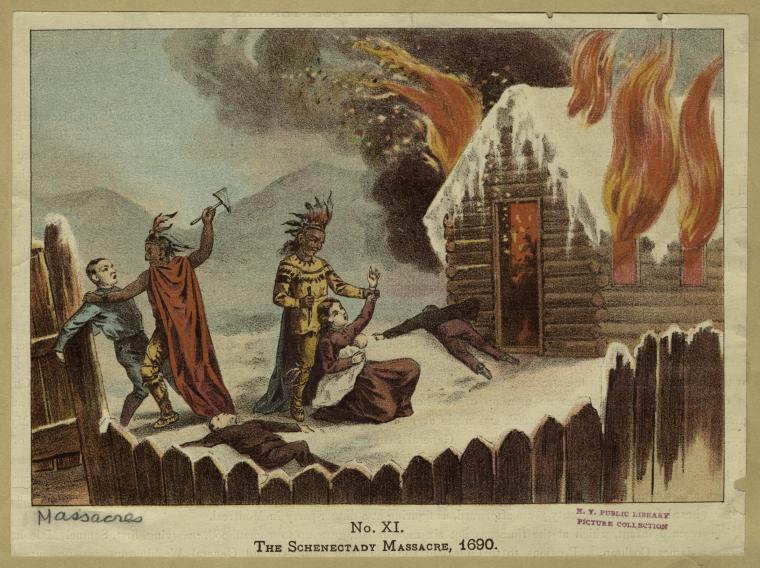
On the night of February 8, into the morning of the 9th, 1690, 60 residents of the frontier village of Schenectady were massacred by a raiding party of French soldiers and their native allies. Monsieur De Monsignat, identified as “Comptroller General of the Marine” in Canada, wrote an account of the massacre that is one of the most detailed records we have. Abridged here, the full version can be found in Pearson’s “History of the Schenectady Patent.”
“At eleven of the clock at night, they came within sight of the town (but) resolved to defer the assault until two o’clock of the morning. But the excessive cold admitted of no further delay.
“The town of Corlaer [Schenectady, being referred to by the surname of its founder, Arent Van Curler] forms a sort of oblong with only two gates – one opposite the road we had taken; – the other leading to Orange, which is only six leagues distant. Messierus de Sainte Helene and de Mantet were to enter at the first…, and which in fact was found wide open. Messieurs d’Iberville and de Montesson took the left with another detachment, in order to make themselves masters of that leading to Orange. But they could not discover it, and returned to join the remainder of the party. A profound silence was every where observed, until the two commanders, who separated, at their entrance into the town for the purpose of encircling it, had met at the other extremity.
“The signal of attack was given Indian fashion, and the whole force rushed on simultaneously. M. de Mantet placed himself at the head of a detachment, and reached a small fort where the garrison was under arms. The gate was burst in after a good deal of difficulty, the whole set on fire, and all who defended the place slaughtered.
“The sack of the town began a moment before the attack on the fort. Few houses made any resistance, M. de Montigny discovered some, which he attempted to carry sword in hand, having tried the musket in vain. He received two thrusts of a spear – one in the body and the other in the arm. But M. de Sainte Helene having come to his aid, effected an entrance, and put every one who defended the place to the sword. The massacre lasted two hours. The remainder of the night was spent in placing sentinels, and in taking some repose.
“The house belonging to the minister was ordered to be saved, so as to take him alive to obtain information from him; but as it was not known, it was not spared any more than the others. He was slain and his papers burnt before he could be recognized.”
Sixty residents were killed during the attack, and more died on the march to Montreal; only two French were killed, and one wounded. Some unknown number of Schenectadians escaped and fled the town; one account holds that 25 such fugitives lost limbs as a result of the extreme cold that night. Symon Schermerhoorn managed to mount a horse and, despite being shot through the thigh, rode through the deep snow to Albany to raise the alarm.
The next morning, second in command Pierre Le Moyne d’Iberville (who would go on to found Louisiana) and the Mohawk called Kryn crossed the icy river to the home of Johannes Glen (some accounts give his brother Sander), who was prepared to defend his family and servants. However, d’Iberville said he had orders to leave Glen undisturbed, owing to kindness that Glen had shown to French captives of the Mohawks. He was allowed to go to the ruins and that any of his kin who survived would be released; he applied this privilege so freely that the Canadian Mohawks objected. Glen was able to convince the French not to take female captives to Montreal. After the alarm was raised at Albany, Captain Bull was charged with burying the dead, but pursuit was left to some Mohawks, who set out late; only a small number finished the pursuit, finding a straggling group of the French and killing them just outside Montreal.
De Monsignat closed his account thus:
“The return march commenced with thirty prisoners. The wounded, who were to be carried, and the plunder, with which all the Indians and some Frenchmen were loaded, caused considerable inconvenience. Fifty good horses were brought away. Sixteen of these only reached Montreal. The remainder were killed for food on the road … Such, Madame, is the account of what passed at the taking of Corlaer. The French lost but twenty-one men, namely four Indians and seventeen Frenchmen. Only one Indian and one Frenchman were killed at the capture of the town. The others were lost on the road.”
Tomorrow: The Roll of the Dead.

Leave a Reply